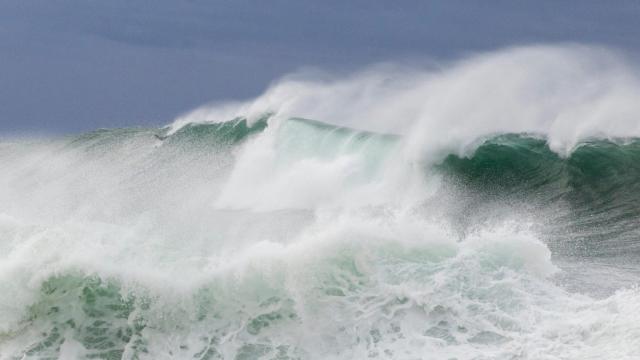There’s no shortage of evidence the Arctic is unravelling into a new and strange state. The latest example is honestly one of the weirdest I’ve come across in nearly a decade reporting on the issue.
A new study published in Geophysical Research Letter this week chronicles how Arctic sea ice’s disappearance has led to more open water and waves that are creating more clouds. The mechanism for this process is even more wild: The waves are ejecting organic matter into the sky that becomes the nuclei of tiny ice particles. Oh, and the organic matter is increasing in the seas ringing the Arctic because they’re getting warmer water transported from the Pacific, making those seas more productive. Like I said, extremely weird!
The intricate study took place in the Chukchi Sea, which sits just north of the Bering Strait. Researchers from Japan gathered an incredible array of data in November 2018 on the trip for the new study. To study the ocean and sky above it, they observed the temperature, wind, humidity, cloud cover, and ocean productivity using a variety of instruments on the R/V Mirai.
While satellites have been used to monitor cloud cover in the Arctic, extensive on-the-ground (or more accurately, on-the-ocean) data is more challenging to come by. Jun Inoue, a geoscientist at Japan’s National Institute of Polar Research who led the study, said in email the researchers planned the trip for November because the ice-strengthened research ship could handle the conditions, offering “a great chance to find a new process.”
That hunch turned out to be correct. Inoue and his group observed ice crystals forming in clouds during a period of relatively high waves and strong wind. The group was able to sample what are known as ice-nucleating particles, basically tiny bits of solid matter that ice can form around and condense into clouds. Soot, sea salt, and even pollution can all be part of that process. But tests on the samples Inoue and his colleagues gathered show that the particles were likely from oceanic organic matter.
Inoue noted that sea ice’s disappearance isn’t happening in a vacuum and its loss “can modify many things (winds, waves, ocean structure, aerosols, clouds),” all of which interact with each other. The new study neatly shows that. Previous research has shown that Arctic and Pacific Oceans are blurring together where they meet. (A similar process is happening in the Atlantic.) On impact of that blurring is that those areas are becoming more productive, with tiny organisms floating throughout the water column.
At the same time, climate change is eating into sea ice. Oh, and the Arctic is getting stormier. All that have now conspired to kick up more waves full of little critters and plant matter, which in turn are leading to more nuclei for ice particles in the air. I don’t mean to repeat myself, but this is all extremely weird!
But it’s also more than just an odd climate change fact you can bust out at parties. (Wait, I’m hearing I’m the only one who does this. Hmm.) The research has very real implications for climate modelling in the Chukchi and other shallow Arctic seas to figure out what comes next. The study notes changing cloud cover could, in a strange twist in a paper full of them, actually help protect sea ice by leading to increased snowfall. That’s not a given, of course, and it won’t magically reverse the long-term dire trend and outlook for sea ice. But it does point avenues for refining projections. Inoue said the research will also expand to the Antarctic as well.
“We will start the Antarctic expedition in 2022 (6 yrs project),” he wrote. “Representation in clouds over the Southern Ocean has a large uncertainty in climate models. The water depth in the Southern Ocean is deeper than the Chukchi Sea; however, we think there would be the same kind of air-sea interaction related to cloud formation.”
